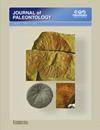Elongate Ediacaran fronds from the Flinders Ranges, South Australia
IF 1.6
4区 地球科学
Q3 PALEONTOLOGY
引用次数: 0
Abstract
Decimeter-scale, elongate, fossil fronds from the Ediacara Range in South Australia were formally described as Rangea longa Glaessner and Wade, 1966, but the disparate nature of documented specimens has hindered their inclusion in global syntheses and has resulted in these fossils being assigned to at least five different genera in two different clades since their discovery. Detailed study of the type material from the Ediacara Range and the few specimens subsequently collected elsewhere in the Flinders Ranges reaffirms that these specimens represent a single species, with the apparent morphological variation between specimens entirely taphonomic and reflecting the obverse and reverse surfaces of these fronds coupled with the orientation of the frond axis and petaloids at different angles relative to the sea bottom on which they were preserved. The preserved architecture of these fronds constitutes three orders of branching microstructure that are strictly orthogonal to immediately higher and lower orders. This implies affinities with the arboreomorphs, but representing a new frond genus herein named Akrophyllas. Akrophyllas n. gen. differs from all other Ediacaran fronds in exhibiting a stalk that is visible only on one side of the frond and is internal to the other side where the first-order branches instead meet at a zigzag axial trace. Akrophyllas n. gen. was attached to a bulbous holdfast on the sea bottom, and evidence for current scours that formed in the lee of the fronds and for a strong current alignment of felled fronds with depositional overlap of adjacent fronds imply an upright, epibenthic lifestyle for Akrophyllas longa new combination. UUID: http://zoobank.org/86e26477-7b1e-45da-870c-1b5d28fc510c来自南澳大利亚弗林德斯山脉的细长埃迪卡拉叶
1966年,南澳大利亚埃迪卡拉山脉的分米级细长化石叶被正式描述为Rangea longa Glassner和Wade,但记录标本的不同性质阻碍了它们被纳入全球综合,并导致这些化石自发现以来被分为两个不同支序中的至少五个不同属。对埃迪卡拉山脉的模式物质和随后在弗林德斯山脉其他地方采集的少数标本的详细研究重申,这些标本代表一个单一物种,标本之间的明显形态变化完全是直拍的,反映了这些叶片的正面和反面,再加上叶片轴和花瓣相对于保存它们的海底的不同角度。这些叶子的保留结构构成了三级分支微观结构,它们严格正交于直接的高阶和低阶。这意味着它和树状形态有亲缘关系,但代表了一个新的叶属,在这里被命名为Akropellas。Akropellas n.gen.与所有其他埃迪卡拉叶的不同之处在于,其茎仅在叶的一侧可见,而在另一侧内部,一级分支以Z字形轴向轨迹相交。Akropellas n.gen.附着在海底的一个球茎状固定物上,有证据表明,在叶背风中形成了洋流冲刷,砍伐的叶与相邻叶的沉积重叠形成了强烈的洋流排列,这意味着Akropillas longa新组合具有直立的表海底生活方式。UUID:http://zoobank.org/86e26477-7b1e-45da-870c-1b5d28fc510c
本文章由计算机程序翻译,如有差异,请以英文原文为准。
求助全文
约1分钟内获得全文
求助全文
来源期刊

Journal of Paleontology
地学-古生物学
CiteScore
2.80
自引率
7.10%
发文量
94
审稿时长
6-12 weeks
期刊介绍:
The Journal of Paleontology publishes original articles and notes on the systematics, phylogeny, paleoecology, paleogeography, and evolution of fossil organisms. It emphasizes specimen-based research and features high quality illustrations. All taxonomic groups are treated, including invertebrates, microfossils, plants, vertebrates, and ichnofossils.
 求助内容:
求助内容: 应助结果提醒方式:
应助结果提醒方式:


